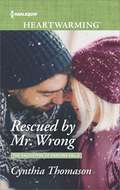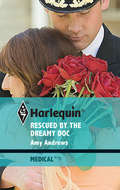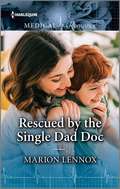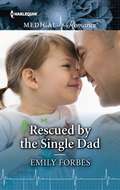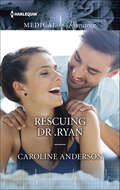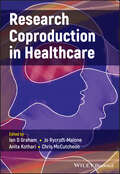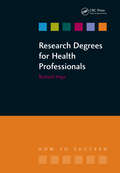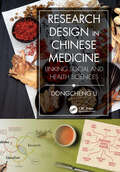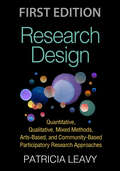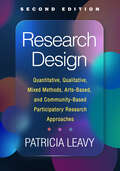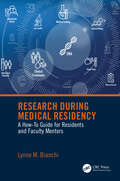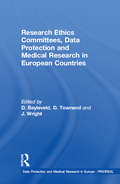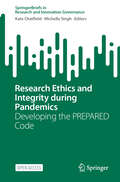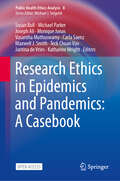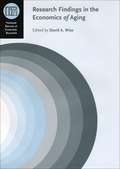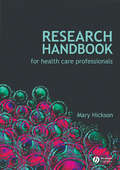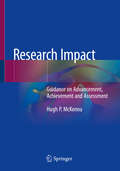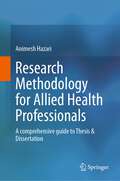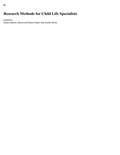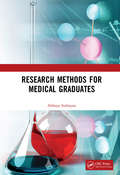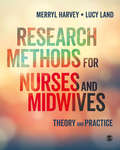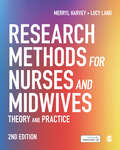- Table View
- List View
Rescued by Mr. Wrong
by Cynthia ThomasonLife is meant to be lived Surprising her family for Christmas seems like a good idea...until Carrie Foster loses control of her car in a freak blizzard. Now she's stuck in the middle of nowhere with a fractured leg, the unplanned-for guest of the man who saved her life. Keegan Breen lives in a secluded cabin on his family's neglected campgrounds, which nature-lover Carrie sees as a potential paradise. The haunted war correspondent is a world away from the boy he was once. But together, can they prove the cynics wrong and show that opposites can not only attract, but be soul mates?
Rescued by the Dreamy Doc
by Amy AndrewsNurse Callie Duncan tells herself she's finally put the pieces of her life back together. Then drop-dead-gorgeous world-renowned psychologist Sebastian Walker arrives at her hospital. . . . Seb recognizes the pain behind Callie's beautiful face and fiery temperament and decides they might be just what each other needs for a very welcome distraction!Nights spent in the roguish Seb's strong arms jump-start Callie's badly broken heart. And now the fiercely independent Callie must let this dreamiest of doctors deliver a real fairy-tale ending.
Rescued by the Single Dad Doc: Rescued By The Single Dad Doc / The Midwife's Secret Child (the Midwives Of Lighthouse Bay) (Mills And Boon Medical Ser.)
by Marion Lennox“So you’re rescuing me? Like you’ve rescued three kids and a dog already?”Life has taught Dr. Rachel Tilding the hard way that she can’t afford to let her guard down—ever! Except her new boss, Dr. Tom Lavery, hasn’t read the memo. He’s known for sheltering all manner of waifs and strays, and Rachel feels uncomfortably like Tom’s latest project! She should be pushing back, but somehow Tom and his boys are starting to heal her wounded heart…“What an entertaining, fast-paced, emotionally-charged read Ms. Lennox has delivered in this book…. The way this story started had me hooked immediately….”—Harlequin Junkie on The Baby They Longed For“…the chemistry between this couple was strong and present from the moment they come face-to-face, as these two still have pretty intense feelings for each other; the romance was heart-warming….”—Harlequin Junkie on Finding His Wife, Finding a Son
Rescued by the Single Dad: Rescued By The Single Dad / The Doctor's Marriage For A Month (Mills And Boon Medical Ser.)
by Emily ForbesFalling in love…With her rescuer!When paramedic Patrick Reeves discovers Dr. Charli Lawson trapped after a landslide, he holds her hand until she’s freed. They will never forget the connection of that night, but Patrick is a single dad with a broken heart, and Charli has already lost everything! She tries to stay away but he slips past her defenses. Could her courageous but scarred rescuer—and his adorable three-year-old—help heal Charli’s lonely heart?“This is the best book I’ve read by Ms. Forbes so far and I was hooked right from the beginning….”— Harlequin Junkie on Reunited with Her Brooding Surgeon“…it was riveting and tugged at my heartstrings due to the emotional back story of the heroine and all this couple go through on their journey to happy ever after.”— Harlequin Junkie on One Night That Changed Her Life
Rescuing Dr. Ryan
by Caroline AndersonThe injured hero!Will Ryan is supposed to be training Lucie Compton as a family doctor, yet here he is with two injured arms, relying on her for every undignified little thing! It’s more than his pride can take.She disrupts his peace, his life, his dignity—and she’s beautiful! She’s loud, willful and the dog prefers her to him. She’s kind, thoughtful…and he’s dreaming about her! Not that he’d ever tell her.Lucie decides to save this grumpy but gorgeous soul from himself—and get him to pursue his real desires! In fact, she makes rescuingDr. Ryan her very next challenge….
Rescuing the Paramedic's Heart: Falling Again For The Animal Whisperer / Rescuing The Paramedic's Heart (bondi Beach Medics) (Bondi Beach Medics #1)
by Emily ForbesYou can’t heal a heart……by keeping your distanceParamedic Poppy is back in Sydney. Her first stop? Bondi Beach’s surf and sand! There’s just the small matter of bumping into the bay’s newest elite lifeguard—Ryder Evans, her first love, who was forced to move away…taking a piece of Poppy’s heart with him. If she wants him back, she must be bold enough to let gorgeous Ryder show her what she’s been missing.From Harlequin Medical: Life and love in the world of modern medicine.Bondi Beach MedicsBook 1: Rescuing the Paramedic’s Heart
Research Coproduction in Healthcare
by Ian D. Graham Jo Rycroft-Malone Anita Kothari Chris McCutcheonA ground-breaking and rigorous presentation of coproduction in research In Research Coproduction in Healthcare, a team of experienced applied health researchers and decision makers deliver a robust exploration of collaborative ways on how to plan and conduct healthcare research. The book explores relational skills that are essential to achieving successful coproduction, including trust through humility, ongoing communication, emotional intelligence, and the structures and processes required to work with a range of knowledge users. It also sets out the fundamentals of research coproduction and its transformative potential for more effective and efficient health systems and improved health outcomes. Readers will also find: A thorough introduction to the planning, implementation and evaluation of research coproduction, including how to write a successful research coproduction proposal Comprehensive explorations of capacity-building and infrastructure requirements Practical discussions of the theory of coproduction, including treatments of power and tokenism In-depth reflections on the essential building blocks of research coproduction Perfect for researchers, knowledge users, funders, trainees and organizations, Research Coproduction in Healthcare will also earn a place in the libraries of coproduction teams, policymakers, clinicians, and health system managers.
Research Degrees for Health Professionals
by Richard Hays Lesley HallamInterested in undertaking research training? More health professionals are considering enrolling in a postgraduate degree that includes research training, and many are choosing to do this part-time within already busy personal and professional lives. Many are also choosing to conduct research in areas that involve more than one traditional discipline or are closely linked to their professional practice. The challenges they will face are quite different to those of typical full-time students moving on from a first degree. This practical book guides health professionals, and the academic faculty who supervise them, through developing research ideas based on professional practice to successful completion and graduation with either masters or doctoral level degrees. Research training can be a complex process. It is daunting trying to juggle a personal and professional life, and help and advice on this is otherwise hard to find. This book is ideal for healthcare professionals undertaking, or considering undertaking part-time research training. It is also invaluable for full-time research students, and will be a great source of information for academic supervisors and course organisers. 'This book is written for all those poor souls who feel an inclination to undertake further education in a way that answers questions relevant to their work. Research training does not need to be seen as daunting. There is a wide range of research training available, from lower level coursework modules through to higher level, research project-based programmes, many of them designed for full-time study. Few practicing health professionals have the time or the inclination to suspend professional work and study full-time, and so embark on complex pathways that combine research and professional practice. The choice of pathways is potentially confusing and there are numerous challenges to reaching a satisfactory outcome and maintaining sanity. With careful planning, prediction of potential pressure points, and early detection of challenges and intervention, research training even amidst complex lives, can be very rewarding and even life-changing.' - Richard Hays, in the Preface.
Research Design in Chinese Medicine: Linking Social and Health Sciences
by Dongcheng LiResearch Design in Chinese Medicine: Linking Social and Health Sciences is an innovative and comprehensive guide that bridges the ancient wisdom of Traditional Chinese Medicine (TCM) with modern research methods in social and health sciences. Authored by an expert with a background in Chinese medicine and a doctorate in education from Johns Hopkins University, this book is set to revolutionize the way TCM is studied and practiced in the contemporary world.Designed for a diverse readership, from TCM students and practitioners to those in social sciences and holistic medicine, the book provides a unique integration of traditional techniques and modern research approaches. It offers invaluable resources for Doctor of Acupuncture and Herbal Medicine (DAHM) students, helping them deepen and refine their research skills. Additionally, it serves as an essential academic tool for educators in TCM and related fields, perfectly suited for course adoption in over 50 accredited acupuncture schools within the U.S. and extending its reach globally.Research Design in Chinese Medicine: Linking Social and Health Sciences offers a balanced emphasis on both qualitative and quantitative research approaches. This holistic methodology ensures that readers gain a full spectrum of knowledge, from formulating research questions to conducting ethical studies. The step-by-step guide provided in the book is supplemented with a wealth of resources, including a dedicated website, downloadable templates, and case studies, making it not just a book but a complete learning experience.The book is positioned to be a key resource in the field of TCM research. Its interdisciplinary approach and practical guidance make it invaluable to anyone looking to conduct meaningful research in TCM. The combination of the author's expertise and the practical tools offered makes this book a must-have for students, practitioners, and researchers in the field.
Research Design: Quantitative, Qualitative, Mixed Methods, Arts-Based, and Community-Based Participatory Research Approaches
by Patricia LeavyThis user-friendly book provides a step-by-step guide to using the five major approaches to research design: quantitative, qualitative, mixed methods, arts-based, and community-based participatory research. Chapters on each approach follow a unique format--they present a template for a research proposal and explain in detail how to conceptualize and fill in every section. Terminology commonly used within each approach is identified, and key moments of ethical decision making are flagged. Interdisciplinary research examples draw on current events and social justice topics. Unique coverage includes hot topics: replication studies and data sharing, tailoring proposals to different audiences, and more. The book also includes a general introduction to social research; an in-depth, practical discussion of ethics; and a chapter on how to begin a research study, from planning a topic to developing a research question via a literature review. Pedagogical Features *Multiple "Review Stops" in each chapter--quick quizzes with answer keys. *End-of-chapter writing exercises, research activities, and suggested resources. *Bold-face key terms and an end-of-book glossary. *Boxed tips from experts in the respective approaches. *Supplemental PowerPoint slides for instructors using the book in a class.
Research Design: Quantitative, Qualitative, Mixed Methods, Arts-Based, and Community-Based Participatory Research Approaches
by Patricia LeavyWith a new chapter on the literature review, this accessible step-by-step guide to using the five major approaches to research design is now in a thoroughly revised second edition. The prior edition's user-friendly features are augmented by a new companion website with worksheets keyed to each chapter. For each approach, the text presents a template for a research proposal and explains how to conceptualize and fill in every section. Interdisciplinary research examples draw on current events and social justice issues. Unique coverage includes hot topics--replication studies, data sharing, and preregistration; tailoring proposals to different audiences; and more. Terminology commonly used in each approach is identified and key moments of ethical decision making are flagged. The book includes a general introduction to social research, an in-depth discussion of ethics, and a chapter on how to begin a research study. New to This Edition New or expanded discussions of theory and literature in quantitative research, replication studies, preregistration of research, the critical paradigm in qualitative research, mixed methods research, approaching different kinds of organizations in community-based participatory research, and more. Chapter on the literature review, including the ethics of citational practices. Companion website with worksheets to aid in learning and practicing each chapter's key concepts. Updated examples, references, and recommended readings throughout. Pedagogical Features Multiple "Review Stops" in each chapter--quick quizzes with answer keys. End-of-chapter writing exercises, research activities, and suggested resources. Bolded key terms and an end-of-book glossary. Boxed tips from experts in the respective approaches. Pointers to downloadable worksheets throughout the chapters. Author-created PowerPoints and chapter tests with answer keys available to instructors using the book in a course.
Research During Medical Residency: A How to Guide for Residents and Faculty Mentors
by Lynne M. BianchiThis book is a guide for medical residents and faculty in the fundamentals of clinical research, publication practices, and conference skills. It offers advice on how to incorporate scholarly activities into training routines, so the process becomes more manageable and less burdensome. Suggestions for pursuing other scholarly activities, outside of clinical research, are also offered. Participation in research and other scholarly activities is a requirement for graduation from medical residency programs in the United States and many other countries. Faculty physicians who train residents are also required to produce annual scholarly work. Adding scholarship onto an already long list of requirements often feels a bit daunting to medical residents and the faculty who teach them. Fortunately, there are many forms of scholarly activity, including basic and clinical research, quality improvement projects, and educational assessments, so everyone can find interesting and feasible projects to complete. This valuable reference provides users with a reliable source to turn to whenever they have questions on how to develop, conduct, publish, or present a research project. Written with the perspective of busy faculty and residents in mind, the content balances the need for enough detail to be instructive with the need for quick access to key points.
Research Ethics Committees, Data Protection and Medical Research in European Countries (Data Protection and Medical Research in Europe : PRIVIREAL)
by D. TownendThe Data Protection and Medical Research in Europe: PRIVIREAL series represents the results of this EC-funded project examining the implementation of Directive 95/46/EC on data protection in relation to medical research and the role of ethics committees in European countries. The series consists of five separate volumes following the complete development of the PRIVIREAL project. This volume relates to the second stage of this project and is concerned with the setting up and role of research ethics committees. It assesses their legal responsibilities, especially with regard to data protection matters and contains reports from more than 20 European countries on these issues. Focusing on the theoretical role and practical operation of research ethics committees and the impact of relevant international and national instruments, this volume will be an essential resource for all those concerned with data protection issues in medical research.
Research Ethics and Integrity During Pandemics: Developing the PREPARED Code (SpringerBriefs in Research and Innovation Governance)
by Kate Chatfield Michelle SinghThis open-access book is an essential read for anyone interested in pandemic preparedness, research governance, and the ethical oversight of research. It examines the development of a pioneering research ethics framework designed for use during pandemics, guiding readers through the careful development of the PREPARED Code, while highlighting the key steps and lessons learned. The book also underscores the importance of supportive measures, such as user-friendly ethics training, to ensure effective implementation. Drawing from these insights, it offers recommendations for others seeking to develop their own clear, engaging, and accessible ethics code.
Research Ethics in Epidemics and Pandemics: A Casebook (Public Health Ethics Analysis #8)
by Michael Parker Susan Bull Carla Saenz Vasantha Muthuswamy Joseph Ali Monique Jonas Maxwell J. Smith Teck Chuan Voo Jantina De Vries Katharine WrightThis open access casebook addresses complex and important ethical challenges arising when health-related research in conducted in the context of epidemics and pandemics. This book provides contextually-rich real-world case studies illustrating research ethics issues encountered by researchers, ethics reviewers and regulators around the globe during the COVID-19 pandemic. The accompanying commentaries outline relevant conceptual approaches and ethical considerations. These promote understanding and reflection on relevant ethical issues, ethical approaches and competing considerations in a manner supporting thoughtful evaluation of their implications for practice. As such the casebook is relevant to academic and professional audiences with an interest in global health, research ethics, and outbreaks and epidemics.
Research Findings in the Economics of Aging
by David A. WiseThe social and economic effects of this shift are significant, and in Research Findings in the Economics of Aging, a group of leading researchers takes an eclectic view of the subject. Among the broad topics discussed are work and retirement behavior, disability, and their relationship to the structure of retirement and disability policies.
Research Handbook for Health Care Professionals
by Mary HicksonThe Research Handbook for Health Care Professionals is the essential guide to the entire research process for students and practitioners alike. From conceiving an idea for a project to writing up the findings for publication, the book offers an overview of each stage plus hints and tips, recommendations for further reading and examples spanning a wide range of health professions. The book comprises three sections: Getting Started, Doing Your Research and Writing Up and Dissemination, and includes chapters on key topics such as formulating your research question, writing the initial research protocol, application for ethical approval, research governance, collecting your data, research methods and preparing a poster for a conference.
Research Impact: Guidance on Advancement, Achievement and Assessment
by Hugh P. McKennaResearch for research sake is no longer tenable or affordable; to be valuable to society, research must have impact! This textbook takes the reader on a journey from how the UK Research Excellence Framework assesses impact to real examples of outstanding research impact case studies. Along the way, Prof. Hugh McKenna describes and explains the case for research impact, the challenges, the link between research impact and evidence informed practice, achieving impact through changing policy and engaging with the public, how researchers can make their research findings more impactful and how research impact is assessment nationally and internationallyIt is written in an easily accessible and understandable style, with reflective exercises amply distributed throughout its pages and helpful guides helping to engage readers and notably health professionals who are often turned off by the normal heavy research tomes. This book makes the complex simple and the wearisome fascinating. The short chapters are interesting and authoritative and can be read on a ‘standalone’ basis, allowing readers to ‘dip in and out’.From his experience in various countries, the author has a unique insight into what research impact is, how it is assessed and how and where research findings can have the most benefit. The stimulus for this book has been the excellent feedback that the author has received from health professionals, students and fellow researchers. There is always a risk that good knowledge and experience do not transfer well into a good textbook. In Research Impact: Guidance on Advancement, Achievement and Assessment, nothing has been lost in the transition. The book will be of great interest to many health researchers from nursing to midwifery, pharmacy, medicine or any allied health professional, but also to any research manager in all professions who want their research to bring positive change to society, culture, the economy, health and quality of life. It will be of particular interest to those who want to understand the difference between research impacts that are weak and those that are outstanding and how such assessments are made.
Research Methodology for Allied Health Professionals: A comprehensive guide to Thesis & Dissertation
by Animesh HazariResearch Methodology is one of the essential subjects for Master's and Ph.D. students, which requires a comprehensive understanding of the subjects with their scientific application. This book would target all aspects, including detailed information on components of research methodology, to enable readers to conduct and write their research work. Thus, the book covers a larger audience in the allied health stream, focusing on university students and Ph.D. scholars. The language of the book is simple and lucid, with multiple illustrations for easy understanding. Ultimately the book would aim to prepare competitive health professionals to render the highest quality of research work and enable them to transform it into their clinical practice. With years of vast experience and research output, the project will have a great success and fruitful outcome.
Research Methods for Child Life Specialists
by Sarah Daniels Sherwood Burns-Nader Jessika BolesIn todays evidence-based healthcare culture, child life specialists must demonstrate knowledge and skill not only in clinical care, but also in planning and evaluating the impact of their interventionsyet few resources exist to provide research skills and support for these practitioners. To adequately evaluate, improve, and innovate patient and family outcomes, it is essential that all providers understand the key inquiry pathways of research. <p><p>Combining clinical examples and skills with candid advice from seasoned child life specialist researchers, this text scaffolds the concept of inquiry into feasible units of action. From identifying a clinical question to assembling a team, designing a project, collecting and analyzing data, and reporting on results, it guides students, professionals, and administrators in actively exploring and improving healthcare outcomes for patients and their families. <p><p>Case examples from the authors own experiences as clinicians and researchers serve to demonstrate how to seamlessly translate clinical skills into those needed for success in research, ensuring that child life specialists remain active contributors to todays research evidence on the needs of children and families during healthcare encounters.
Research Methods for Medical Graduates
by Abhaya IndrayanThis book discusses the why and how of each step of data-based medical research that can provide basic information to emerging researchers and medical graduate students who write theses or publish articles. The chapters are arranged in the sequence of steps for data-based research. The research steps are comprehensively covered from the selection of the topic to the final publication. Reporting methods such as CONSORT, STARD, and SAMPL guidelines are also covered. Each chapter has separately earmarked examples from the contemporary literature that illustrate the different research methods. Key Features Discusses all the steps of data-based medical research Examines the topics in depth by way of examples from contemporary literature Features notable information in boxes for special attention .
Research Methods for Nurses and Midwives: Theory and Practice
by Dr Merryl Harvey Lucy LandThis book is the only research methods book you need to succeed whilst studying nursing and midwifery. Ideal for all pre and beyond registration nurses, this book has everything you need to know about consuming, critiquing and using research; it then builds on this foundation to develop these ideas into workable practice for real-world research. Inspired by over 25 years combined experience, the authors have structured the book around the complimentary spheres of theory and practice and take you through each step of the research process, demonstrating how to choose a question, design your research proposal, collect data, analyse your findings and write up your research. It explores: · Evidence-based research · Literature and systematic reviews · Ethics · Secondary Data · Research design · Methodologies and individual methods · Data analysis – quantitative and qualitative Interwoven with case studies and embracing quantitative, qualitative and mixed methods alike, this balanced textbook provides an introduction to a wide range of theories and methods and is packed full of material specially created to meet student and instructor needs. Whether you are new to research methods or returning to formal education and hoping to conduct your own research, this book is your ideal companion.
Research Methods for Nurses and Midwives: Theory and Practice
by Dr Merryl Harvey Lucy LandThis book is the only research methods book you need to succeed whilst studying nursing and midwifery. Ideal for all pre and beyond registration nurses, this book has everything you need to know about consuming, critiquing and using research; it then builds on this foundation to develop these ideas into workable practice for real-world research. Inspired by over 25 years combined experience, the authors have structured the book around the complimentary spheres of theory and practice and take you through each step of the research process, demonstrating how to choose a question, design your research proposal, collect data, analyse your findings and write up your research. It explores: · Evidence-based research · Literature and systematic reviews · Ethics · Secondary Data · Research design · Methodologies and individual methods · Data analysis - quantitative and qualitative Interwoven with case studies and embracing quantitative, qualitative and mixed methods alike, this balanced textbook provides an introduction to a wide range of theories and methods and is packed full of material specially created to meet student and instructor needs. Whether you are new to research methods or returning to formal education and hoping to conduct your own research, this book is your ideal companion.
Research Methods for Nurses and Midwives: Theory and Practice
by Lucy Land Merryl HarveyThis book walks you step-by-step through the whole research process so you can get up to speed understanding and doing your own research. In their friendly, down to earth style, the authors lay the theoretical foundations you need to consume and critique research, before showing how to translate this into action when tackling your own literature review or research project. This second edition: Draws on a wealth of examples from midwifery, four fields of nursing including mental health nursing and child nursing, and a range of health care specialities. Covers new and updated NMC professional education standards and maps all relevant policy and law. Supports your learning with reflective exercises, online activities and quizzes that enable you to be confident in your understanding and develop your thinking. Whether you’re encountering research and evidence-based practice for the first time or refreshing your methods knowledge, this is the ideal research companion for nurses and midwives pre-registration, post-registration and beyond.
Research Methods for Nurses and Midwives: Theory and Practice
by Lucy Land Merryl HarveyThis book walks you step-by-step through the whole research process so you can get up to speed understanding and doing your own research. In their friendly, down to earth style, the authors lay the theoretical foundations you need to consume and critique research, before showing how to translate this into action when tackling your own literature review or research project. This second edition: Draws on a wealth of examples from midwifery, four fields of nursing including mental health nursing and child nursing, and a range of health care specialities. Covers new and updated NMC professional education standards and maps all relevant policy and law. Supports your learning with reflective exercises, online activities and quizzes that enable you to be confident in your understanding and develop your thinking. Whether you’re encountering research and evidence-based practice for the first time or refreshing your methods knowledge, this is the ideal research companion for nurses and midwives pre-registration, post-registration and beyond.
